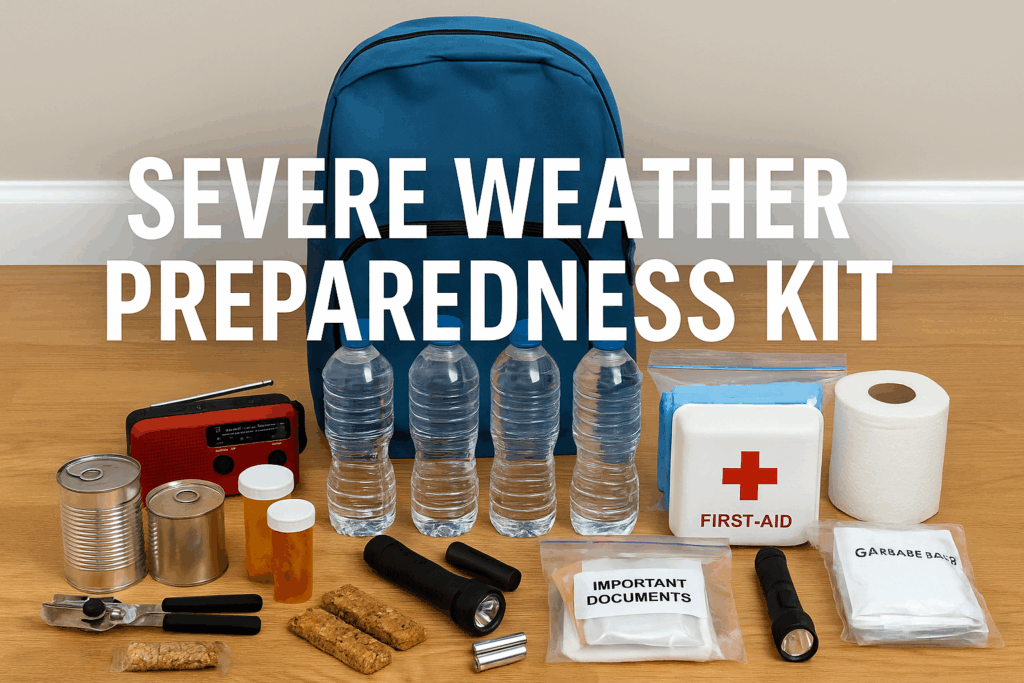Building the Ultimate Severe Weather Preparedness Kit

When severe weather strikes—whether it’s a tornado, derecho, blizzard, or flood—being prepared can mean the difference between safety and chaos. A well-stocked severe weather preparedness kit gives you and your family the essentials to ride out power outages, limited access to stores, or even temporary displacement. Below, we’ll walk through the core items every kit should have, plus extra communication tools and food ideas to help you stay safe and comfortable.
Water and Food Essentials
- Manual Can Opener: Don’t overlook this small but vital tool if your kit includes canned goods.
- Water: Store at least one gallon per person, per day for three days. This covers both drinking and sanitation.
- Food: Choose non-perishable items that are easy to prepare and require little or no cooking.
Non-Perishable Food Ideas
- Proteins: Canned tuna, chicken, salmon; peanut butter; jerky; protein bars.
- Grains & Cereals: Crackers, dry cereal, instant oatmeal, quick rice or pasta.
- Fruits & Vegetables: Canned green beans, corn, peaches, pears, dried fruit, applesauce pouches.
- Soups & Stews: Canned chili, hearty soups, or dehydrated mixes.
- Drinks: Powdered milk, electrolyte mixes, instant coffee or tea.
- Comfort Foods: Cookies, chocolate, hard candies, and even spices to make simple meals more enjoyable.
Pro Tip: Rotate your food and water supply every six months to ensure freshness.
Communication & Light Sources
Staying informed and visible during an outage is crucial.
- NOAA Weather Radio: A battery-powered or hand-crank radio with tone alerts keeps you updated on warnings and advisories.
- Flashlight with Extra Batteries: Store multiple for each family member.
- Whistle: A simple, effective tool for signaling help.
Backup Communication Options
While a NOAA radio is essential, consider adding redundancy:
- Text Messaging: Often more reliable than calls if cell towers remain powered.
- Two-Way Radios (FRS/GMRS): Great for family communication within a neighborhood or campsite.
- Ham Radio: Reliable for longer distances, though it requires a license and training.
- CB Radio: A no-license option useful within a five-mile range.
- Satellite Phone or Communicator: Pricey but the most dependable when all else fails.
- Wired Landline Phone: Works during outages if connected to traditional copper phone lines.
Health and Sanitation Supplies
- First Aid Kit: Stock with bandages, gauze, antiseptic wipes, antibiotic ointment, and any special family needs.
- Medications: Include a 7-day supply of prescriptions and key over-the-counter items (pain relievers, antihistamines, etc.).
- Sanitation Supplies: Moist towelettes, garbage bags, plastic ties, toilet paper, and feminine hygiene products.
- Dust Masks: To help filter out debris or contaminated air.
Important Documents and Financial Preparedness
In a crisis, access to personal records can be just as vital as physical supplies. Keep copies of identification, insurance policies, medical documents, and financial papers in a waterproof pouch or folder. Store a small amount of cash in smaller bills, since card readers and ATMs may not work during an outage. It’s also helpful to carry a written list of emergency contacts, including at least one person outside your immediate area who can act as a communication point.
Clothing, Tools, and Comfort Items
The practical basics of daily living shouldn’t be overlooked. Pack a change of clothes for each family member, along with sturdy shoes, seasonal outerwear, and gloves. Blankets or sleeping bags are essential for warmth if the power is out for an extended period. Basic tools like a multipurpose knife, pliers, or a wrench can help shut off utilities if necessary. And while it may seem minor, comfort items such as books, puzzles, or games can help children (and adults) cope with the stress of an extended emergency.
Storing Your Kit
Once you’ve gathered everything, store your kit in a durable, waterproof container like a plastic bin or backpack. Make sure it’s easily accessible and that everyone in your household knows where to find it. Ideally, your kit should be portable, allowing you to grab it quickly if you need to evacuate.
Severe weather is unpredictable, but your response doesn’t have to be. With a well-stocked preparedness kit, reliable backup communication, and practical food supplies, you’ll be ready to keep your family safe, nourished, and informed no matter what comes your way. Start small by gathering the basics, then add to your kit over time. When the next storm hits, you’ll have peace of mind knowing you’re prepared.